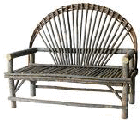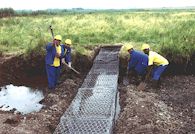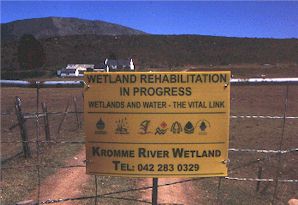VALUE ADDED INDUSTRIES
Working for Water has embarked on a programme to contribute to the sustainable management and control of invasive species, and to add value to the clearing operations. A programme promoting the utilization of biomass from clearing operations was researched since 1998, 1st at a very limited scale but since 2002 the programme was expanded substantially. |
The value added industries (VAI) programme has three primary objectives:
- maximising the positive economic benefits of the WfW programme, by creating extra jobs through the harvesting and processing of plant material;
- reducing the net cost of clearing, thereby contributing to the sustainability of the WfW programme
- minimising potential negative environmental impacts, such as fire damage, by leaving less biomass behind after clearing
Interventions in Value Added Industries takes place within a strategic as well as a local context. Development has been done in order to develop informed national or large-scale strategies as well as local interventions in the form of pilot projects. |
 |
|
The utilisation of biomass is expected to create an additional benefit stream for WfW, and concurrently create the opportunity for economic empowerment of historically disadvantaged individuals (HDIs). This will be achieved through the development of down-stream industries, which will operate either independently, or as partnerships between the public and private sectors.
The removal of cleared biomass, particularly from the Western Cape, southern parts of the Eastern Cape, North West and Mpumalanga Provinces, has for many reasons become essential. In doing so: biological diversity is conserved; water security is improved through the enhancement of streamflow and ground water sources; ecosystem processes such as the impacts of fires and floods improved; the productive potential of land restored and sustainable use of natural resources promoted.
What do we produce?
The brochure shows a small selection of Value Added Industries’ products. (See also the links to some of the producer websites.) Other products include:
|
- screens and blinds
- décor items for interior/lifestyle shops
- bathroom accessories
- lights and lamps
- indoor and outdoor furniture
- fencing, arches and other garden furnishings
- wooden educational toys
- firewood, charcoal and woodchips.
|
 |
|
By buying these products people contribute both to supporting environmentally sound products, produced by emerging small business, and to supporting the WfW programme as a whole and its objectives of water security, biodiversity/natural diversity, economic empowerment, ecological processes and social development.
|
Value Added Industries
|
 |
|
WETLAND PROJECTS
WfW and DEAT have formed a partnership
to address wetland rehabilitation. In 2001/2 R30 million has been
allocated towards wetlands projects throughout the country.
The projects include national priority wetlands
(including existing and proposed Ramsar Wetlands of International
Importance).
The employment to be created from implementing
these projects is expected to be over 2000 people. Most of the
projects in 2000/1are considered to have been highly successful,
judging by the immediate response of the wetlands and the amount of
sediment trapped by erosion control structures within only a few
months after construction.
Rehabilitation work carried out by workers
employed in the wetlands projects includes gabion construction, the
removal of invasive alien plants in the immediate area, surveying of
flood irrigation furrows, construction and placing of grass bale
gabions and leveling of drainage furrows.
List of wetland projects in RSA :
| E Cape
The Berg Seekoei River
Gatberg Wetland
Namakwe
Kromme
Ntsikeni Nature Reserve |
Mpumalanga
Hazyview wetlands
Blairemore / Izithunba
Verloren Valei
Blyde/Treur
Lakenvlei Crane/Upper Elands
Wakkerstroom & Biosphere Reserve
Loskop Dam |
| Free
State
Seekoeivlei
Upper Wilge |
North-West
Soshunguwe-Tswaing
Boitekong-Rustenburg
Molopo |
| Gauteng
Greater JHB
Jukskei
Colbyn
Rietvlei |
N
Province
Nyl River
Mokolo |
| Kwazulu-Natal
Mbongolwane
Gladstone vlei
Ntambhlope
Lenjane |
W Cape
Rietvlei
Wildevoelvlei
Lotus River/Edith Stephens |
For
additional information on wetlands in South Africa, visit Wetlands-l
- a newsgroup that has been set-up to serve the interests of those
interested in South African wetlands. http://listserv.ru.ac.za/mailman/listinfo/wetlands-l
 |
WfW workers construct gabions at a wetland
in the NW/Gauteng region. |
 |
Farmers in the Kromme River area show their
support for wetlands rehabilitation on their property. |
|